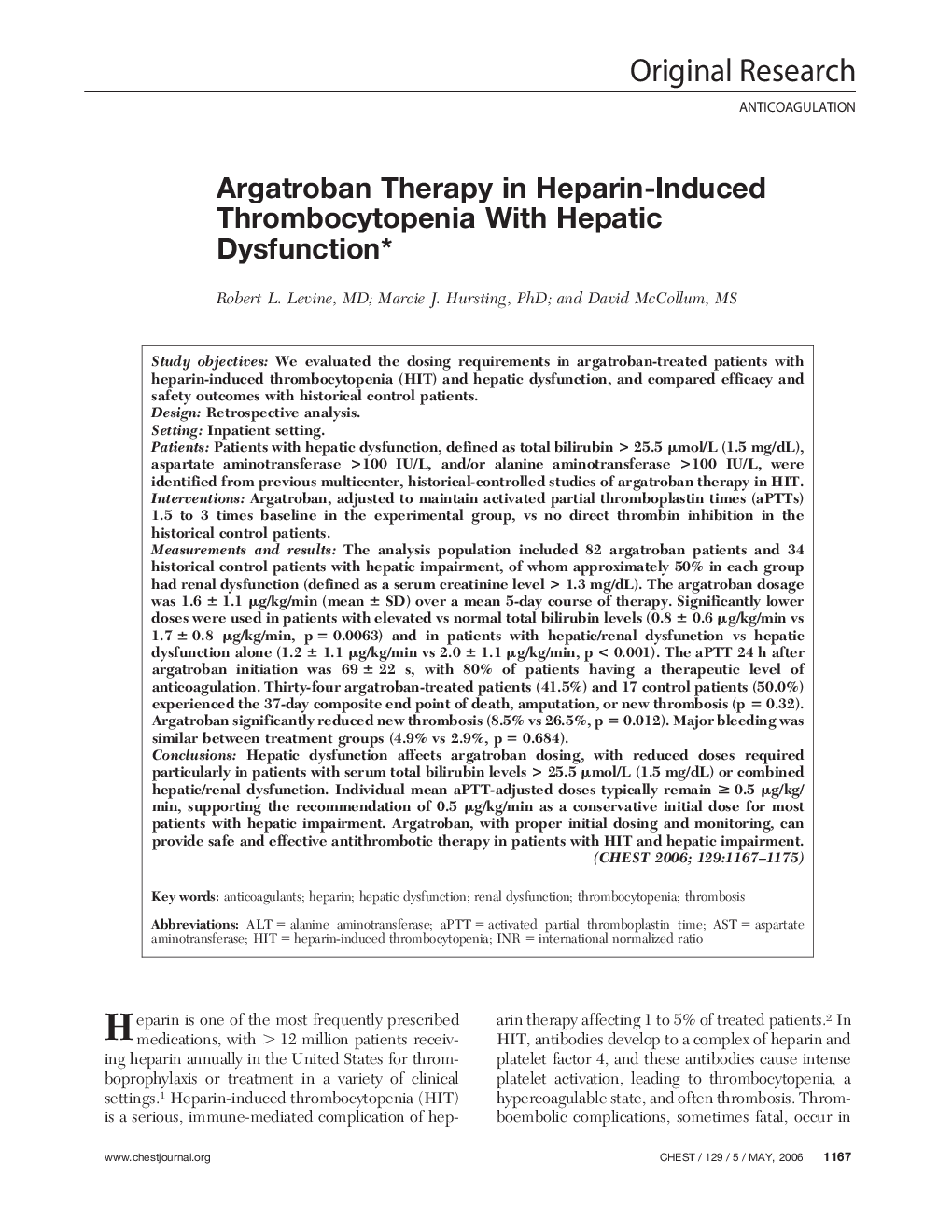| کد مقاله | کد نشریه | سال انتشار | مقاله انگلیسی | نسخه تمام متن |
|---|---|---|---|---|
| 2905879 | 1173438 | 2006 | 9 صفحه PDF | دانلود رایگان |

Study objectivesWe evaluated the dosing requirements in argatroban-treated patients with heparin-induced thrombocytopenia (HIT) and hepatic dysfunction, and compared efficacy and safety outcomes with historical control patients.DesignRetrospective analysis.SettingInpatient setting.PatientsPatients with hepatic dysfunction, defined as total bilirubin > 25.5 μmol/L (1.5 mg/dL), aspartate aminotransferase >100 IU/L, and/or alanine aminotransferase >100 IU/L, were identified from previous multicenter, historical-controlled studies of argatroban therapy in HIT.InterventionsArgatroban, adjusted to maintain activated partial thromboplastin times (aPTTs) 1.5 to 3 times baseline in the experimental group, vs no direct thrombin inhibition in the historical control patients.Measurements and resultsThe analysis population included 82 argatroban patients and 34 historical control patients with hepatic impairment, of whom approximately 50% in each group had renal dysfunction (defined as a serum creatinine level > 1.3 mg/dL). The argatroban dosage was 1.6 ± 1.1 μg/kg/min (mean ± SD) over a mean 5-day course of therapy. Significantly lower doses were used in patients with elevated vs normal total bilirubin levels (0.8 ± 0.6 μg/kg/min vs 1.7 ± 0.8 μg/kg/min, p = 0.0063) and in patients with hepatic/renal dysfunction vs hepatic dysfunction alone (1.2 ± 1.1 μg/kg/min vs 2.0 ± 1.1 μg/kg/min, p < 0.001). The aPTT 24 h after argatroban initiation was 69 ± 22 s, with 80% of patients having a therapeutic level of anticoagulation. Thirty-four argatroban-treated patients (41.5%) and 17 control patients (50.0%) experienced the 37-day composite end point of death, amputation, or new thrombosis (p = 0.32). Argatroban significantly reduced new thrombosis (8.5% vs 26.5%, p = 0.012). Major bleeding was similar between treatment groups (4.9% vs 2.9%, p = 0.684).ConclusionsHepatic dysfunction affects argatroban dosing, with reduced doses required particularly in patients with serum total bilirubin levels > 25.5 μmol/L (1.5 mg/dL) or combined hepatic/renal dysfunction. Individual mean aPTT-adjusted doses typically remain ≥ 0.5 μg/kg/min, supporting the recommendation of 0.5 μg/kg/min as a conservative initial dose for most patients with hepatic impairment. Argatroban, with proper initial dosing and monitoring, can provide safe and effective antithrombotic therapy in patients with HIT and hepatic impairment.
Journal: Chest - Volume 129, Issue 5, May 2006, Pages 1167–1175